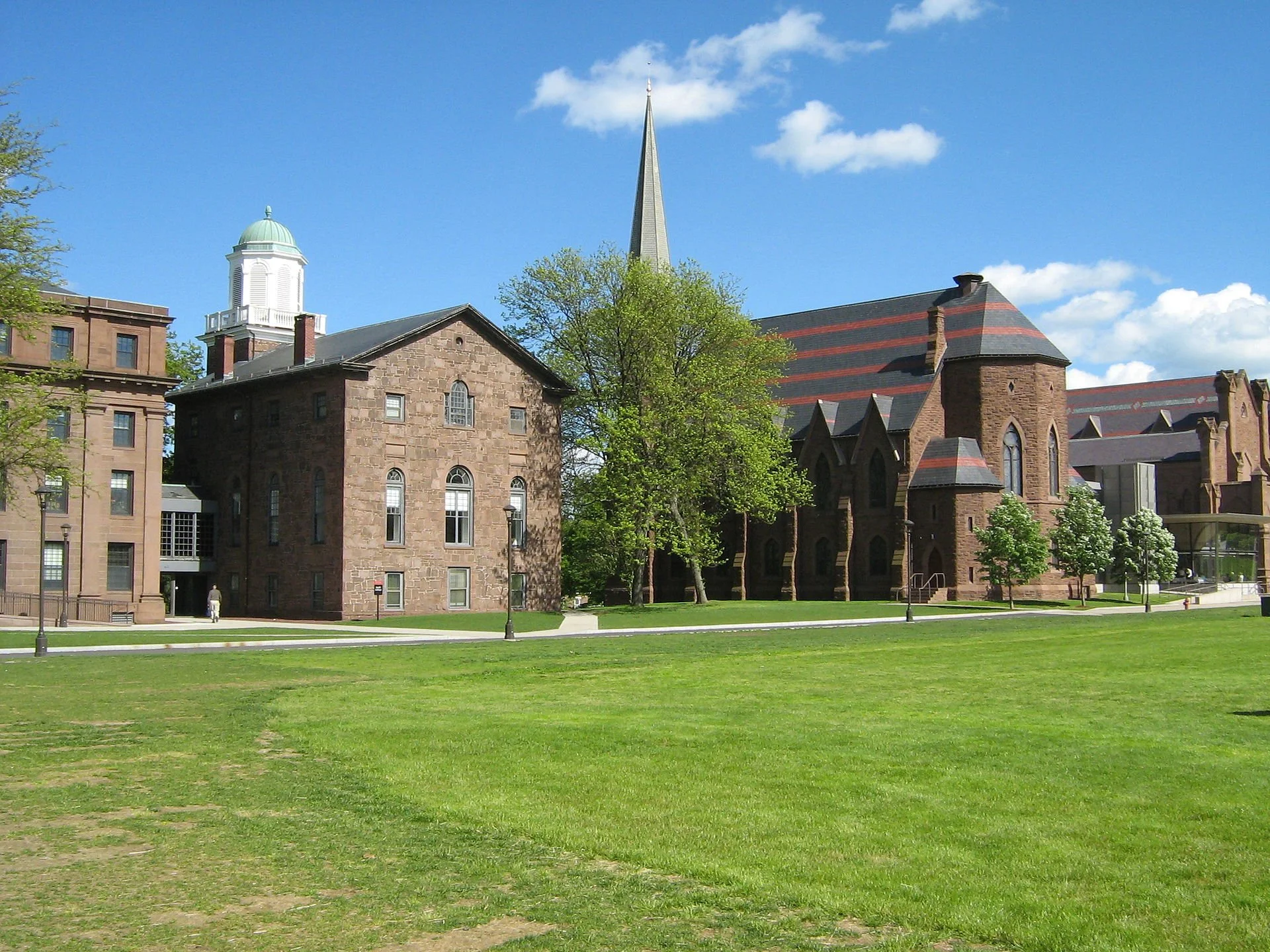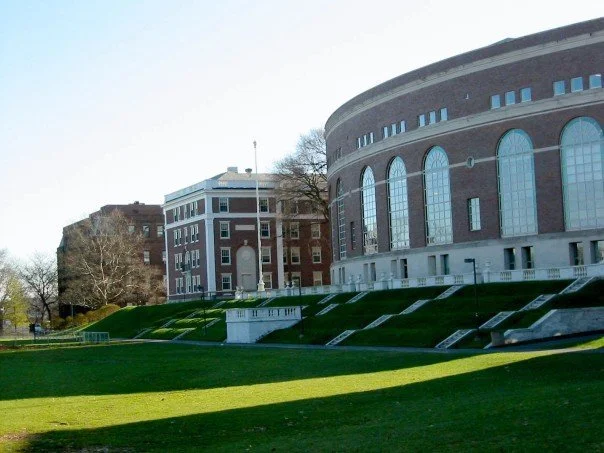
n
Chris Powell: Has abortion really become state’s highest social good? the phony U.S. debt-ceiling crisis
The rear of College Row at Wesleyan University in Middletown, Conn. From left to right: North College, South College, Memorial Chapel, Patricelli '92 Theater
— Photo by Smartalic34
MANCHESTER, Conn.
Maybe nothing less could have been expected from Wesleyan University in Middletown, Conn., a citadel of leftist groupthink, but according to the university chapter of the Democratic Socialists, the university has agreed to pay for abortions for its students. Not for treatment of cancer or multiple sclerosis or Crohn’s disease or AIDS or other serious ailments, just abortions.
The university’s implication is that while those ailments are often fatal, abortion is the highest social good.
Wesleyan’s decision rhymes with the clamor at the state Capitol, where proclamations of fidelity to abortion rights trump the daily shootings in the cities, the repeat offenders running rampant, the collapse of public education, the worsening poverty, and the government’s shift away from public service to a mere pension and benefit society.
The people who extol abortion well may believe that it is the highest social good. Yet their clamor seems a bit out of place in Connecticut, where a Roe v. Wade policy on abortion was enacted years ago and will remain in force whatever other states do with their new freedom to legislate on the issue. In Connecticut, abortion anywhere, any time is challenged only by occasional calls for requiring parental notification for abortion for minors. While parental notification has broad support with the public, nothing can sway the abortion fanatics in control of the General Assembly’s Democratic caucus.
So abortion fanaticism may be meant mainly as a distraction from the defects of both the national and state Democratic administrations. It presumes that clamor about abortion can induce most people to forget about inflation, forever wars, open borders, and the soaring national debt as long as there is a chance that the law somewhere might impede abortion of viable fetuses.
The political judgment of Connecticut’s abortion fanatics may be correct. After all, so much nuttiness in the state now goes without serious challenge -- from transgenderism to unemployment benefits for strikers to reimbursing the abortion expenses of women in abortion-restricting states who come to this state for abortions.
Still, the fanatics might not represent majority opinion or even anything close to it. If their power is mainly their ability to intimidate those who disagree, their position could actually be weak.
Connecticut won’t find out what the public really thinks until some people in public life try talking back -- calmly and rationally but firmly -- daring to attempt argument.
xxx
Hysteria has overtaken the controversy over the limit on the federal government’s debt.
The other day Treasury Secretary Janet Yellen warned that the refusal by Republicans in Congress to raise the debt ceiling would cause a “constitutional crisis” that might cripple the economy and financial system as the government ran out of money and defaulted on some of its bonds.
Nonsense. Because it retains the power of money creation, the federal government can never run out of money. It can create money to infinity. The government prefers not to create money so frankly, since it might be inflationary, but the government has the power.
And of course the government can raise revenue in a way that won’t aggravate concerns about inflation. It can raise money the old-fashioned way: through taxes.
So why the insistence on more borrowing?
It’s because Congress and President Biden, like his predecessors, enjoy distributing infinite goodies without having to make current taxpayers pay for what they really cost. The burden is to be transferred to future generations -- and to other countries, which the U.S. government pressures to finance this country’s debt, and thus its parasitic lifestyle. The president and Congress believe that Americans have the right to live at the expense of the rest of the world.
Calling again for raising the debt ceiling, Biden says: “America is not a deadbeat nation. We pay our bills.” But we don’t pay our bills, since borrowing to pay debt doesn’t repay debt at all. It just creates more debt.
Taxes repay debt, but apparently a “constitutional crisis” is preferable to more taxes.
Chris Powell is a columnist for the Journal Inquirer, in Manchester. (CPowell@JournalInquirer.com)
Why we need schedules
Annie Dillard.
— Photo by Phyllis Rose
At Wesleyan University, in Middletown, Conn. The view from Foss Hill: From left to right: Judd Hall, Harriman Hall (which houses the Public Affairs Center), and Olin Memorial Library
“How we spend our days is, of course, how we spend our lives. What we do with this hour, and that one, is what we are doing. A schedule defends from chaos and whim. It is a net for catching days. It is a scaffolding on which a worker can stand and labor with both hands at sections of time. A schedule is a mock-up of reason and order—willed, faked, and so brought into being; it is a peace and a haven set into the wreck of time; it is a lifeboat on which you find yourself, decades later, still living.”
―Annie Dillard (born 1945), in The Writing Life. The American author of fiction and nonfiction books taught for 21 years at Wesleyan and has long had a summer house on Outer Cape Cod, a place that she has frequently written about.
‘Had their look down’
Wesleyan University’s Samuel Wadsworth Russell House, built in 1828, home to the school’s Philosophy Department. The building was designated a National Historic Landmark in 2001 and is considered one of the finest examples of Greek Revival architecture in the country.
“I remember I grew up in Pasadena in a very, kind of, homogeneous, kind of, suburban existence and then I went to college at Wesleyan University in Connecticut. And there were all these, kind of, hipster New York kids who were so-called 'cultured' and had so much, you know, like knew all the references and, like, already had their look down.’’
Mike White (born 1970), screenwriter and actor
Those overrated old mills; defending fraternities
Some can be renovated for artists’ lofts and small businesses and their owners can make a profit — often with special tax breaks. The mass of taxpayers must make up the lost tax revenue. And some owners are big tax deadbeats. Consider the owners of Hope Artiste Village, in Pawtucket, who owe the city $124,690 for the current tax year, or those of The Thread Factory, on the Pawtucket-Central Falls line, who owe Pawtucket $366,306 and Central Falls $410,000. There may be similar examples around the state.
It is hard to quantify how much Rhode Island has gained or lost from trying to preserve old mills because people think that they’re quaint. Many can never be retrofitted to make a fair (without tax breaks) profit. Preservationists (not a few of whom are financially secure and don’t have to worry too much about finding a job in the sluggish Rhode Island economy) fiercely fight to save as many of these mills as possible, once built for economically logical reasons that disappeared decades ago. Indeed, the Ocean State has not exactly become a boom town during all these years of trying to keep old factory buildings that don’t make anything anymore except the occasional arsonist.
Then there’s that Art Deco tower the Industrial Bank Building, which, because of its stepped-back structure and location in not exactly thriving Providence, has little chance of being a full-scale office building again. Maybe it would work for residential — but again with tax breaks to be paid for by people not benefiting from its redevelopment.
A rather similar stepped-back famous Art Deco skyscraper is the gold-roofed United Shoe Machinery Corporation Building, at 140 Federal St. in downtown Boston, which for many years was New England’s tallest building. It had been slated for demolition in 1981, after “Shoe,” as the once huge company was long called, disappeared. But Boston was/is a major financial center. The quantity of local money and tax breaks made retrofitting it attractive, and the building is now filled with Class A offices.
Providence doesn’t have that critical mass. Other than nostalgia, there’s little to justify taxing the public to maintain the now remarkably inefficient “Superman Building.” Anyway, Providence had its heyday before it was built and could have another after it’s gone. And even Chartres Cathedral will one day disappear. As Ira Gershwin wrote, “In time the Rockies may crumble, Gibraltar may tumble ... ”
The South Bronx, the famously poor and crime-ridden section of New York given up for lost 30-40 years ago, has enjoyed a revival in part because so many of the old buildings were torn down (often after arson) and new buildings put up in the newly available acreage. Perhaps Rhode Island should move away from its love affair with old factories that do nothing (or worse) for the macro-economy. New buildings can be beautiful too. Are old mills over-rated?
***
The cover story in this month’s Atlantic is titled “The Fraternity Problem: It’s Worse Than You Think.” The article, surprisingly, spends a lot of ink on a nasty fraternity at very liberal/PC/“Little Ivy” Wesleyan University, in Middletown, Conn., where various outrages involving booze, sexual assault and so on have taken place. (Harvard also has fraternities, called “Final Clubs,” where, as a guest, I have witnessed grotesque behavior fueled by alcohol and other drugs.)
Busybodies and other social engineers cry out for closing all fraternities, though legally that would be impossible.
Speaking as a past member of a fraternity, I object. At most of these clubs, while drinking goes on sometimes, as it does at many social organizations, activities are much tamer than the “Animal House” cliché. And they play the healthy role of providing a closer sense of community than can the wider and anomie-ridden college or university community. Indeed, fraternities are frequently the venue for the start of lifelong friendships. Many college administrations should monitor these organizations with more rigor and call in the police (the town cops, not the campus cops) when necessary, of course, but, still, fraternities all in all do more good than harm. And without a modicum of freedom of association, society would be very dreary indeed.
I recently got a note from a group that was in the fraternity house I was in in the late 1960s. They’re planning a reunion for next October. As I saw the names, the years peeled back. Dozens are coming, out of (mostly lapsed) friendship and even morbid curiosity.
Robert Whitcomb (rwhitcomb51@gmail.com), a former editorial-page editor of The Providence Journal and a former finance editor of the International Herald Tribune, is a Providence-based writer and editor and a director of Cambridge Management Group (www.cmg625.com)., a health-care-industry consultancy.





